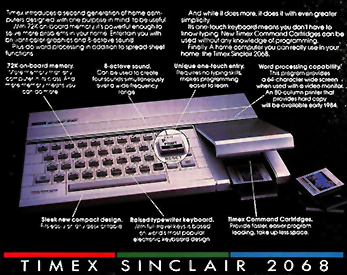
The forgotten American 8-bit computer















Published on 12 September 2024 by Andrew Owen (5 minutes)
Some time around 2010, my friend Bruno Florindo made contact with former Timex Computer boss Lout Galie. I provided the questions, Bruno conducted the interview and I wrote up the response for the original incarnation of Byte High, No Limit. Here is the unedited article:
Many myths surround the Timex Spectrum clones. Bruno Florindo unravels them with Lou Galie, Senior Vice President of Technology at Timex Group USA Inc and former Director of Engineering for the Timex Computer Corporation.
In 1982, Lou Galie left the Burroughs Corporation to lead the design and development of the Spectrum-based TS2000.
“I was convinced Burroughs had no clue about what would be coming in the area of personal computers; Timex were on the leading edge of this revolution.”
As Sinclair’s manufacturing partner, it had already sold over 600,000 ZX81-based TS1000s by 1983. In fact, long after it had left the computer market, Timex continued to sell TS1000 boards to a European commercial refrigeration manufacturer that used them as dedicated controllers.
“I don’t think the boards were manufactured after 1983 though, the orders were filled from inventory.”
The key decision makers were Timex Computer Corporation president Danny Ross, Timex executive vice-president Kirk Pond, and Timex vice-president of research and design Rex Naden who had joined from Texas Instruments (TI).
“Rex argued that the opportunity in the personal computer market was huge and that Timex had product and software advantages over Coleco, Commodore, Atari, Tandy and TI.”
The Spectrum failed to meet FCC part 15 regulations on interference. Timex realized it had to modify the machine and began hiring a team of engineers, starting with Lou.
“Based on the products introduced at CES in early 1983, we decided we’d need something better than a patched-up Spectrum.”
The team was made up mainly of former Burroughs staff, recruited from the closing Danbury, Connecticut engineering group. The rest were local college graduates and a few staff from Timex’s Cupertino, California research facility. Two machines were to be developed; the TS1500 an update of the TS1000, and the TS2000, a complete redesign of the Spectrum.
“The TS1500 was finished in seven months. The TS2000 took 11.”
Both machines were given a better keyboard, more memory, and new firmware. The T52000 also got joy stick and cartridge ports, an extended version of BASIC, and an AY sound chip. Is it a coincidence that the slightly faster Z80 in the TS2068 (3.528Mhz) produces notes closer to perfect pitch than the Spectrum 128? That we don’t know. Despite being able to run only a fraction of Spectrum software, the TS2000 was designed to be 100% backwards compatible.
“We made a special board which let us download a British tape program into memory on one of our ‘plug: in’ modules – and we tested a bunch of packages that way.”
The inclusion of cartridge support was entirely down to the problems the team encountered with loading from cassette.
“It never worked properly. We felt a simple ROM cartridge would solve the 1,001 problems we’d been having.”
Rumors of a TS2016 turn out to be false, but the real story behind the TS2048 can now be told.
“The 2048 and the 2068 are identical, exactly the same! When Danny announced what was supposed to be the 2048, he misspoke and called it the 2068. When I called him on it, he laughed and said: ‘Rename it. 2068 is better than 2048.’”
The T5206S replaced the Spectrum ULA with an SCLD. This fixed various errors in the ULA and added new screen modes, including a 512×192 mode to be included in Sinclair’s Pandora. But, there wasn’t really enough RAM in the TS2068 to make use of the 8×1 attribute mode.
“These modes were planned for future follow-ons to the 2068. We had lots of plans for faster speed, better color, real disk drives, and so on.”
And what about the fabled Bus Expansion Unit?
“We had drawings and a simple prototype, nothing solid. But we had plans for a new chip to enable it to access 16MB of RAM.”
Timex bowed out of the US computer market due to the price war started by Commodore. Rumours persist that the unsold stock was dumped on the Argentinean market, and that somewhere there is a warehouse full of unopened original equipment.
“No. The situation was more complicated than that. When we decided to exit the market we had hundreds of thousands of unsold units. We disposed of them in various ways, using many different outlets.”
Timex sold about 100,000 TS1500s and about 350,000 TS2068s, but this wasn’t the end of the machine. A modified version of the TS2068 was sold as the TC2068 by TMX Portugal, which went on to produce the FDD and FDD3000 disk interfaces, the TC2048, a cut-down TC2068 with better Spectrum compatibility, and the Unipolbrit 2086 for export to Poland. But what about the one known prototype TC3256?
“We had a really smart Portuguese engineer called Al who was involved with our Timex-Sinclair hardware and software work. When we shut the Portuguese factory in the mid-1980s he went on his own and continued work on the 3256. I think he actually built a few”
The Al referred to in the article is the late Alvaro Oliveira. You can find out more about the American and Portuguese Timex computers at https://www.timexsinclair.com/ and https://loadzx.com/timexcomputerworld/. The LOAD ZX Spectrum museum recently did an interview with Danny Ross which you can watch on YouTube.